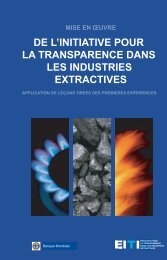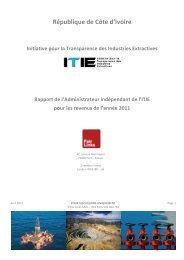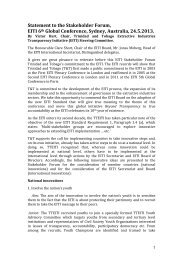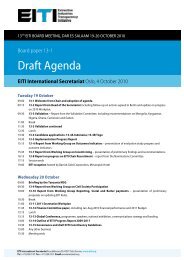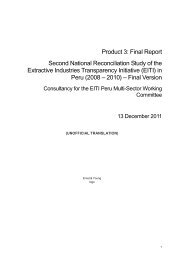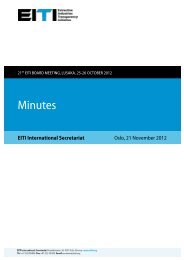Vietnam feasibility study - EITI
Vietnam feasibility study - EITI
Vietnam feasibility study - EITI
Create successful ePaper yourself
Turn your PDF publications into a flip-book with our unique Google optimized e-Paper software.
38<br />
• Environmental protection fee<br />
The environmental protection fee is paid by the company on a monthly basis, based on the production<br />
in line with the guidance of the Circular No. 67/2008/TT-BTC issued by MOF. This is a big receipt that the<br />
local authorities (provinces and cities) are entitled for covering costs of environmental protection activities.<br />
For example, Quang Ninh receives about VND 290 billion per year from this fee. According to almost all<br />
state management agencies and mining companies interviewed, the current environmental protection<br />
fee is still low and unfair among different types of minerals. For instance, the environmental protection<br />
fee applicable to coal exploitation is just VND 6,000/ton. Meanwhile it is VND 50,000/ton for ashlars paving<br />
stone. This is the unfair element among types of minerals because coal exploitation is deemed to cause<br />
much more adverse impact on the environment than that of the exploitation of ashlars paving stone.<br />
On the other hand, the use of funds from the environmental protection fee is not widely publicized,<br />
resulting in people usually blaming the mining company for pollution even though the mining company<br />
may have fully performed its financial obligations for environmental protection. According to the survey,<br />
the fund from the environmental protection fee is sometimes used for the wrong purposes, such as<br />
constructing infrastructures that are not related to environmental protection like cultural halls or roads.<br />
Furthermore, the allocation mechanism of this budget shows many unclear points. Specifically, the<br />
allocation is based on the proposal of each district and approval of the Provincial People’s Committee,<br />
of which the representative is the Department of Planning and Investment. It is not totally based on the<br />
impact of the mining activities on the environment in certain locations. The unclearness in allocation<br />
of the fund for environmental protection activities among different areas combining with the lack of<br />
information disclosure related to that budget has caused bad effects in revenue management.<br />
• Other financial obligations<br />
In fact, some localities collect an amount of money from the mining companies so called “contribution<br />
to the infrastructure” for the purpose of improving infrastructure in areas affected by mining, although<br />
the applicable Ordinance on Charges and Fees as well as the Law on Minerals do not regulate them.<br />
For the Sinh Quyen copper mine in Lao Cai, for example, the local authority collects VND 300,000/ton<br />
of crude copper ore. In Binh Dinh province, the local authority collects the so-called infrastructure fee<br />
for titanium and building stone from the mining company, but the price for each type of minerals, place<br />
and exploitation license is different. Of these, with titanium exploitation, the level of contribution to<br />
the infrastructure construction is between VND 80-160 million/ha under the Decision No. 109/QD-<br />
UBND about the level of contribution to the infrastructure construction in titanium exploitation activity in<br />
the local area issued by Binh Dinh People’s Committee, dated 4/3/2010. With building stones, the level<br />
of contribution to the construction of infrastructure is from VND 3000/m 3 to VND 80, 0000/m 3 for each<br />
type of stone under the Decision No. 2793/UBND-ND about launching the collection of money contributed<br />
for the construction of infrastructure in exploiting building stone issued by Binh Dinh People’s Committee,<br />
dated 16/8/2010. The total amount paid by titanium exploiting enterprises in Phu My district only, Binh<br />
Dinh province, in 2 years (2010-2011) was VND 25.271 billion, of which the amount paid in 2010 was VND<br />
4.647 billion. The money received from contribution of the extractive companies was passed to each<br />
district for maintaining and repairing the infrastructure affected by titanium exploitation.<br />
Apart from these requirements, the mining company may make other payments for such activities as<br />
supporting vocational training, transport roads, and campaigning activities. Though these amounts are<br />
not significant in comparison with financial obligations that the enterprises are required to perform,<br />
they may make the mining company face difficulties in regularizing these payments because they have<br />
no invoice or voucher. Therefore, the company has to include these payments to its after tax profit.<br />
• Some other matters<br />
In addition to problems relating to formal and informal payments, there are also some problems relating<br />
The Extractive Industries Transparency Initiative and the Implementation Perspective of <strong>Vietnam</strong>




